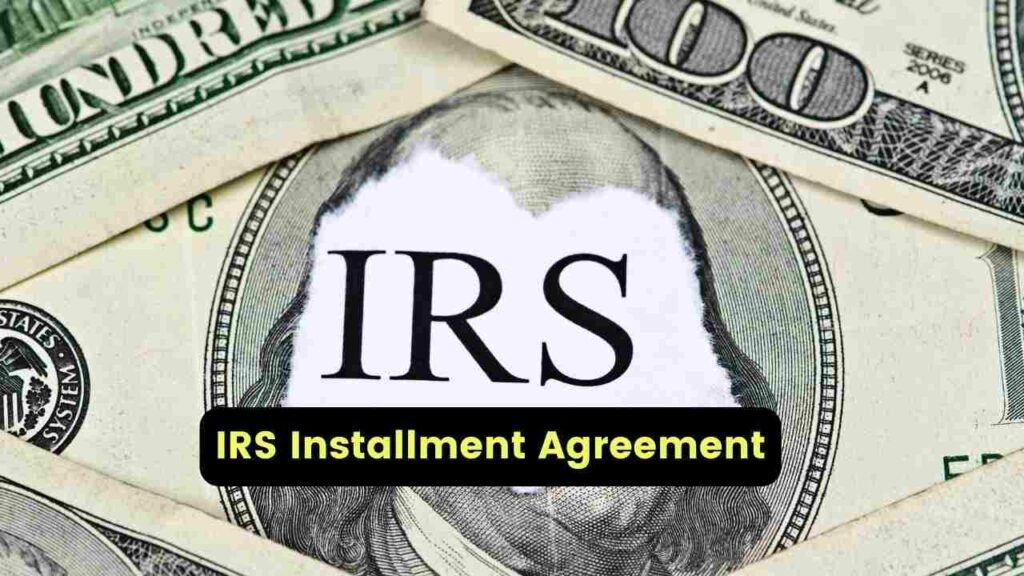The IRS Installment Agreement is all about allowing citizens to pay their federal taxes owed to the government in regular installments. Different installment agreements are designed for people having varied amounts of taxes in debt. This step ensures that citizens pay off their taxes in a much more manageable way instead of paying the amount altogether in one go.
This article, in particular, will discuss everything you need to learn about the IRS Installment Agreement and the steps via which one can successfully set up a Payment Plan with the IRS.

Table of Contents
IRS Installment Agreement
The IRS Installment Agreement, as per the IRS is an agreement that enables candidates who owe federal tax to pay back the amount in installments or within a specific timeframe.
Helping taxpayers prevent harsh tax collection methods adopted by the government including levies or liens. Interested candidates can apply using the two available payment methods, including short-term payment agreements(extending 180 days) and long-term payment agreements(monthly installments).
Depending upon the payment method, certain payment setup fees may be imposed(no user fee is charged for the ones who qualify for the short-term payment plan); information in this regard is aptly covered in the later sections of this article.
Also Check- How to Appeal the SASSA SRD Grant? SASSA R350 Grant
Eligibility Requirements for Different Payment Plans
The eligibility requirements for individual taxpayers and business owners are set differently by the IRS and depend upon the tax owed.
Eligibility Criteria for Individual Tax-owners
Depending upon the amount in debt, individual tax owners can apply for one of the following agreement plans:
- Long-Term Payment Plan (Instalment Agreement): You can apply for the Long-Term Payment Plan only if you have to pay an amount less than or equivalent to $50,000.
- Short-Term Payment Plan: If the amount owed is less than $100,000 after combining tax, penalties, and interests, the person becomes eligible to apply for the Short-Term Payment Plan.
Independent contractors and Sole Proprietors are advised to apply for the Short-Term Payment Plan. The mode of application is going to be online, and additional setup fees may be imposed in case of applying by phone, mail, or in person.
Eligibility Criteria for Business Payment Plan
The eligibility requirements to apply for the Business Payment Plan include:
- Owning a business.
- Filing all the required returns.
- Owing less than or equivalent to $25,000 amount in debt in combined tax, penalties, and interest for the periods covered as per the agreement.
How to set up a Payments Plan with the IRS?
To set up a Payment Plan with the IRS, the following steps are required:
- Step 1: Visit the IRS payment plan set-up application page.
- Step 2: Choose your desired payment plan by finding and clicking on the concerned prompts.
- Step 3: Register if you haven’t already, registered candidates will be required to log on to the site.
- Be prepared with the following information and documents:
- Your SSN (Social Security Number) or Individual Taxpayer Identification Number.
- Employer Identification Number (EIN) for businesses.
- The due amount is as per your tax return or IRS notice.
- Tax records, including past returns and other related documents.
- Select your payment method, like direct debit or check.
How Much Does Setting Up a Payment Plan Cost?
After getting your payment plan approved by the IRS, some amount will be added to your tax bill. This amount varies depending on the mode and type of payment plan you are applying for. Such as:
- Pay Now:
- Pay the total amount via direct pay, check, money order, or card.
- $0 setup fees will be charged.
- No additional penalties or interest will be charged.
- Short-term Payment Plan (180 days or less):
- Paying via Direct Pay, Check, Money order, or card.
- A $0 setup fee is charged.
- Penalties and interests will be imposed until the person pays the full amount.
- Long-term Payment Plan(Monthly Instalment Agreement):
- Direct Debit: A $31 setup fee is required to pay(waived for low-income).
- Non-Direct Debit: $130 setup fees ($43 for low-income households)
- Penalties and interests will be imposed until the person pays the complete amount.
- Several modes of payment are available for the candidate to make payments these may include Direct Debit, Direct Pay, Check, Money order, or card(fees for card payments).
- Reinstating or Revising a Payments Plan: To make modifications to the current plan, an amount of $10 is charged.

During negotiations, this expert acts between you and the interested purchaser’s agent. They might direct you to reliable experts, whether they’re in home assessment or financial advisory. When terms are settled, this specialist will then coordinate a home check and talk with you on potential adjustments, determining who bears the economic responsibility, whether you the interested buyer.